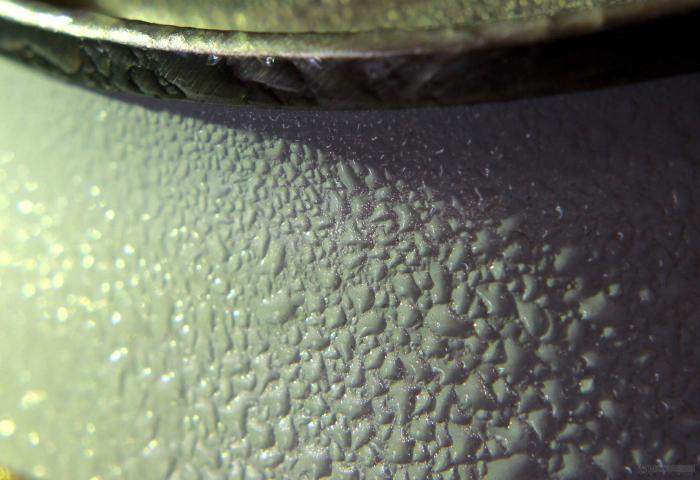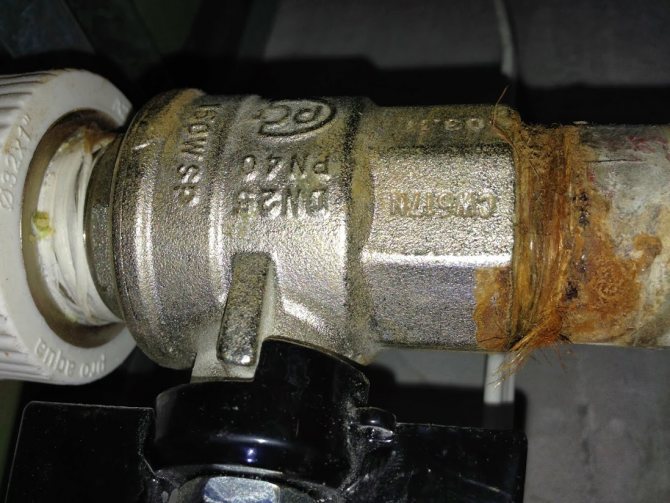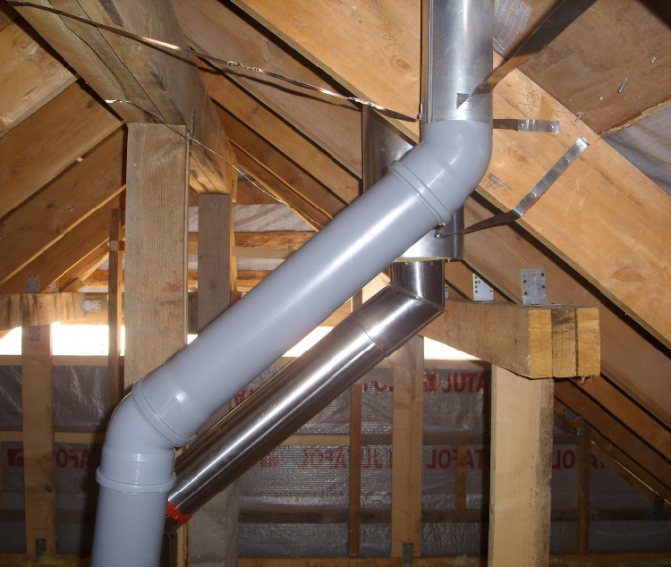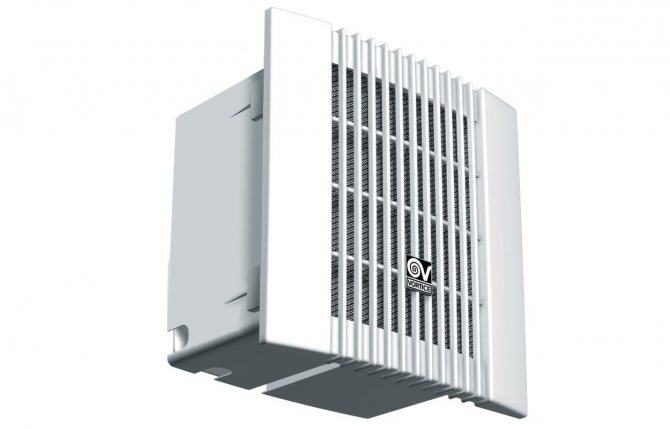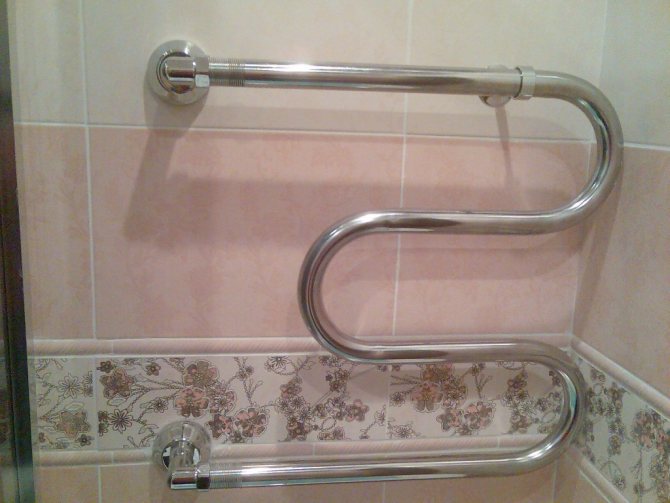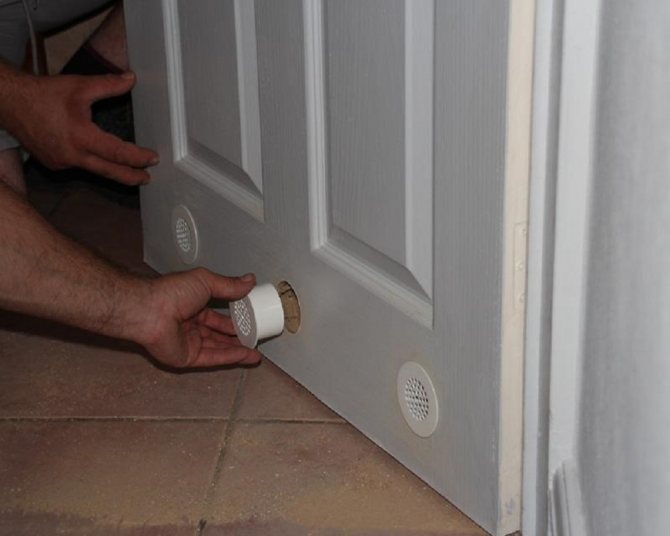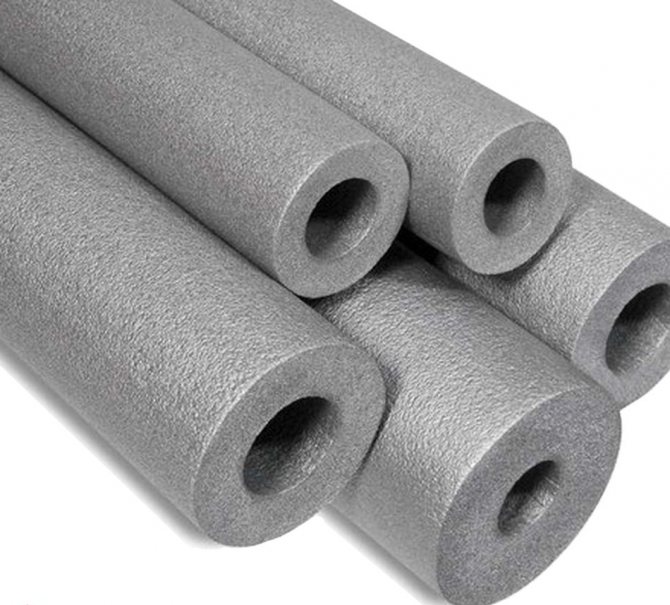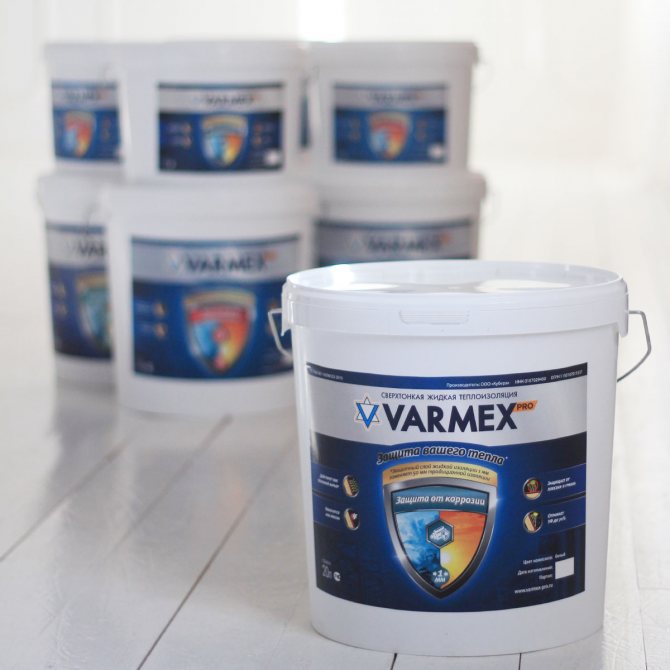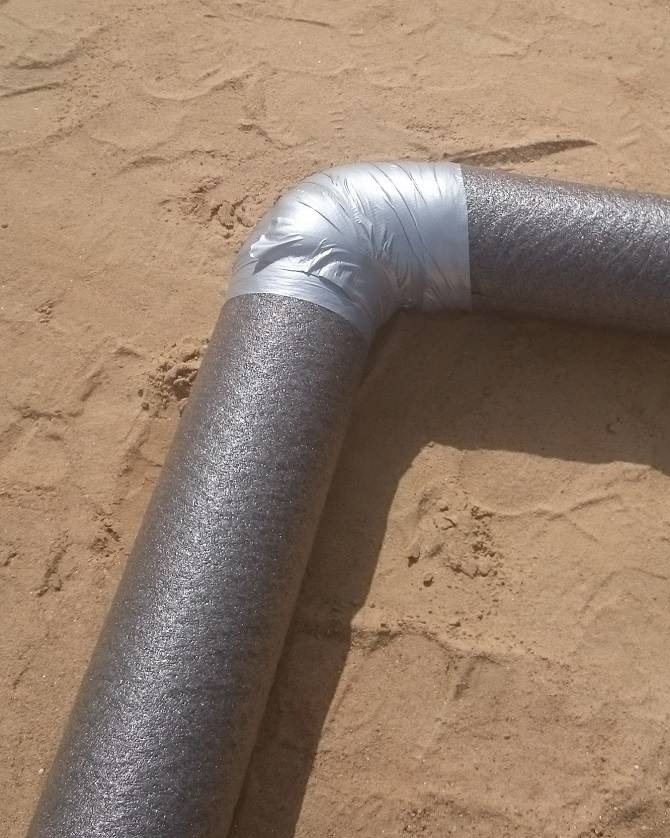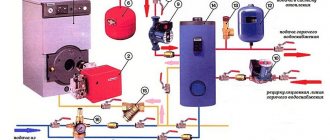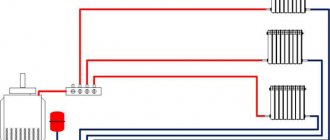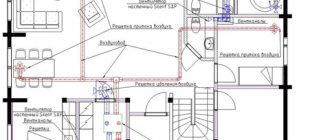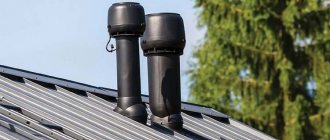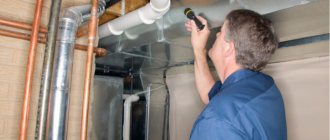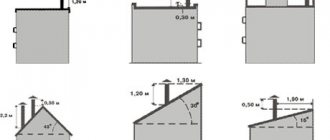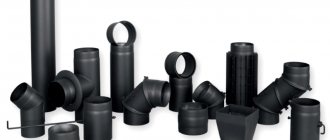You have equipped a ventilation system, but the house still has nothing to breathe, and even damp? So, it's time to think about how to get rid of condensate in the ventilation pipe and prevent its formation in the future. Agree, it is better to solve the problem right away than to endure discomfort for a long time.
We will show you what to do so that you do not have to spend money on replacing ventilation pipes and fighting mold in living rooms. From our proposed article, you will learn how best to prevent and exclude condensation. Our recommendations will help independent home craftsmen.
What is condensation and what harm does it do?
Water is present in the air in a vapor state. When cooled, the steam is converted into liquid water and settles on the inner surfaces of the air ducts in the form of drops, which can drain off, forming rivulets and puddles.
Reasons for the formation of condensation:
- errors in the design and installation of the ventilation system;
- high humidity in the premises;
- the proximity of water bodies;
- large temperature difference inside and outside the house.
Of concern should be not only puddles on the floor, but also rust on the pipes, a decrease in the flow of fresh air, the accumulation of moisture in the walls and ceilings through which the air ducts are laid.
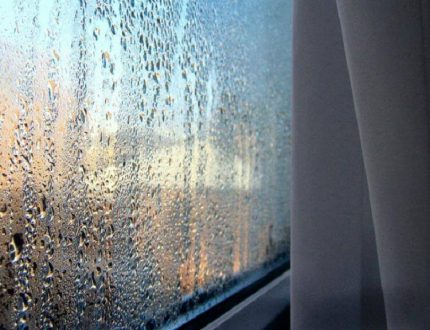
Condensation in the ventilation system leads to an increase in air humidity in the house itself, with effects such as fogging of windows
Condensation is a source of dampness in your home. It serves as a breeding ground for mold and other microorganisms that negatively affect human health. Under the influence of ventilation condensate, metal air ducts are destroyed. Even concrete walls can “feel” the harmful effects of high humidity.
Condensate removal methods
Eliminating condensation from indoor ventilation is the primary task of residents, since high humidity in the premises is fraught with a violation of the microclimate.
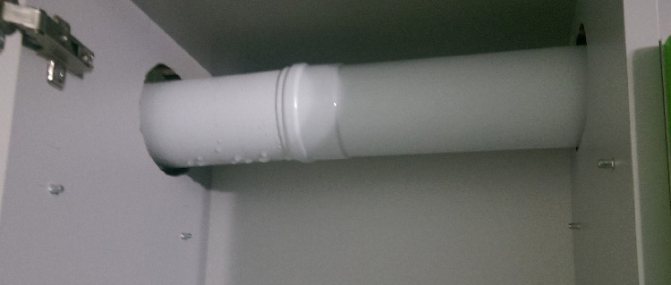

Too humid air in a house or apartment leads to the formation of mold and fungi, which are dangerous for people prone to respiratory diseases (allergic rhinitis, bronchial asthma).
The appearance of a specific smell in the rooms is another consequence of the increased air humidity.
Condensation on the pipes is undesirable in itself, since the liquid contains aggressive components that negatively affect metal and concrete structures. There are many ways to deal with condensation.
Ventilation duct insulation
This method is relevant for private low-rise buildings, where the owners have every right to interfere with the building's internal engineering systems. To insulate air ducts that remove air from the premises from the kitchen, bathroom and living rooms, it may be necessary to temporarily dismantle wall partitions and other non-bearing structures in order to get to the ventilation ducts.


If this can be done, then it is better to use standard insulating materials for sealing and insulating ventilation ducts:
- mineral wool;
- foamed polyethylene;
- Styrofoam;
- polyurethane foam.
We recommend that you familiarize yourself with: Where to correctly and safely hide the heating pipes in a private house?
Depending on the shape of the pipelines and their location, you can use roll insulation, or polyurethane foam shell, which protects the round metal duct pipes.
It is important! The insulating layer must be fastened as tightly as possible so that a gap does not form between the pipe and the insulation layer.
When insulating air ducts, special attention should be paid to areas on the so-called.dew point - the section of transition from the heated room to the attic and exit to the roof. It is also necessary to pay attention to the tightness at the joints of the pipes.
The section of the pipe that comes out of a warm room must be wrapped with insulation, the thickness of which should not be less than 100 mm. On the outer section of the duct - the head of the pipe - a deflector must be installed, which improves traction and protects the duct from atmospheric moisture.
Condensate drainage
Sometimes the owners of the house do not have the opportunity, time and desire to interfere with the ventilation system and insulate the air duct, and in other cases, the insulation does not give the desired result.
In such a situation, it is possible to reconstruct the ventilation system to mechanically remove moisture from the system. To do this, the air duct pipe, which takes air from the premises to the street, is turned in the opposite direction (90 degrees) after preliminary disassembly.
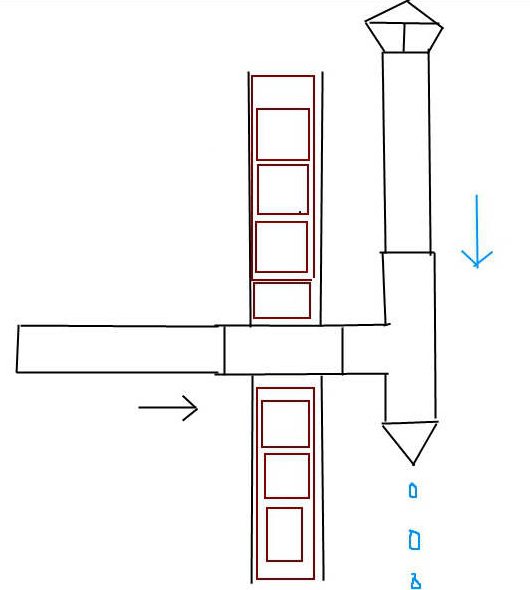

Having installed the pipe in a vertical position, another pipe is installed on top of it, leading to the roof. The section of the pipe, turned downward, will serve to drain condensate, which will simply drain outward. If desired, a conical element can be put on the head of the lower pipe, which serves as a kind of wrench.
Attention! It is possible to install an additional branch pipe, of the type that is in the autonomous boiler heating systems. To do this, you can connect a small flexible tube to the pipe and lead it to the drainage system.
Forced ventilation
If the ventilation system in the house is outdated, then the methods described above for dealing with condensation may not work. In this case, it is recommended to install a new supply ventilation in the house, preserving the old one.
We recommend that you familiarize yourself with: Features of constructing a convector chimney with your own hands
A plug is placed on the air duct of the old system, and an exhaust fan is installed in the window or wall in the kitchen, providing forced circulation. The device will extract air from the room along with microscopic droplets of moisture.
To supply fresh air to the house, you can additionally install wall inlet valves. They are usually cut into the walls next to the heating radiators so that the air masses coming from the street are heated and do not affect the temperature regime.
Removal of condensate outside the ventilation ducts
The collection of condensate in the vertical and inclined sections of the air ducts is carried out in their lower part. On horizontal air ducts, condensate collection can be organized almost anywhere, except for areas laid in the walls.
A socket-tee is installed in the ventilation pipe so that the branch is directed downward. The outlet is equipped with a special container - a condensate trap.
Various types of condensate traps for ventilation can be found commercially. They differ in design and materials of manufacture. They can be transparent, which makes it easier to control the filling, but more often they are made of stainless or galvanized steel.
When filling with condensate, containers with a screw lid are emptied manually, which is not always convenient. Moreover, at an outdoor air temperature of -20 ° C and below, condensation forms especially abundantly and the tank is filled in a short period of time.
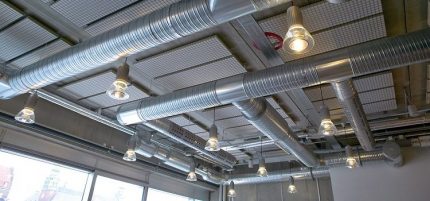

Before installing the condensate collector, the lowest point in the air duct system is determined, but with their horizontal arrangement, the condensate trap can be installed in almost any convenient place
In this case, a conical watering can is a good option. It is easy to connect a hose to it and drain the condensate into the drain. If it is necessary to organize the drainage of liquid in a hard-to-reach place, a model with a watering can is also used.
When organizing the collection and drainage of condensate, the configuration of the ventilation system is taken into account. With multiple pipe bends, you will have to install not one, but several condensate traps.
Sorbents - moisture-retaining substances - also help to collect and remove condensate. They look like cassettes and are installed in the filtration section of the supply air duct. Periodically, the sorbent must be removed for drying, after which it is again ready for use.
Condensate removal is seen as a temporary measure, primarily due to the possibility of ice plugs in winter. Warming of branch channels helps to radically solve the problem.
Condensation in ventilation pipes of an apartment building
Question:
Good day. I wanted to consult about the formation of condensation in the ventilation pipes of an apartment building. On the roof of the five-story building, there is a concrete structure with many round ventilation ducts, 3 of them pass into the apartment.
From the apartment you can see the light entering the ventilation duct from the street. Water flows from the pipes during the cold season. How can this problem be solved?
Mikhail, St. Petersburg.
Answer:
Hello, Mikhail from St. Petersburg!
The problem, however.
If your apartment is not on the ground floor, then you can try to establish a drain of water from condensate even further down. What is done by temporarily removing the ventilation grilles in the apartment and installing small visors inside all three ventilation ducts. True, the neighbors below are unlikely to be delighted with this, since you will shift your problem onto them.
Then the grating is put in place and all the gaps and gaps are coated with silicone sealant. Then the possibility of condensate water getting to you is minimized.
/ I know of a case when a tenant of an apartment with a similar problem completely repaired the holes in his opinion that were superfluous that went into his apartment, leaving only half of one kitchen grate open. Why did I use a roofing tape with raw rubber. /
Well, if you tackle the problem more radically, then it is necessary to insulate all ventilation channels from the very bottom to their top. By using mineral wool (basalt), foil insulation and fastening clamps. If, of course, this is technically possible to implement.
Since condensation occurs due to the difference in temperatures inside the house and outside, even the option of insulating the technical floor (in your case, a concrete structure on the roof of the house) is not excluded. But this requires consultation with the service company and the appropriate work, which will be like a bone in the throat. It is unlikely that she will install exhaust fans, as is done in private houses by the owners themselves. Then the operation of the fans by pumping warm air from the apartments of the house increases the temperature of the ducts and condensation forms to a lesser extent.
It happens that the cause of increased condensation is poor draft or its complete absence in the channels. That is checked by a lighted candle and bringing it to the channel. The candle flame should, with good traction, be intensely deflected towards the channel. If the traction is broken, then the channels are cleaned from the roof with a ruff. A vacuum cleaner is used, which also cleans the inner surfaces of the channels.
To increase traction, it is also sometimes recommended to open a window in the room. Then the draft increases and the warm air of the house warms up the ventilation ducts somewhat.
These are the most common techniques. The device of more sophisticated devices with drainage pipes or the use of silica gel is unlikely to be acceptable to you.
Good luck!
Construction in Moscow and Moscow region
We work with a guarantee! A wide range of construction services. Foundation, walls, floors, roof, turnkey!
+7 (905) 797-20-34
luxurykomfort.ru
Other questions about condensation in rooms:
- Condensation in the garage from the roof how to get rid of
- Condensation inside the house above the well
- Condensation between the heated and no floor of the log house
- Mushrooms on a log house
- Humidity in aerated concrete house
- Condensation in the attic floor after insulation
- The wall in the adobe house is damp
- The wall in a log house in winter gets wet
- The walls in the house are damp
- Condensation under the floor of the extension
- The corners of a brick house are wet
- Condensation in ventilation pipes of an apartment building
- Condensation from the profiled sheet roof
- Will the insulation get damp in winter in an unheated house?
- Mold in a new log house
- Home mushroom what to do
- Condensation in wood floor insulation
- High humidity in a brick house
- Dampness in an old house without a foundation
- Condensation on the ceiling of a one-story thermal house
- How to get rid of dampness underground
- How to clean a vegetable pit on the first floor loggia
- Mold on hardwood floors in a brick house
- Condensation from inside the roof of a plastic balcony
- Condensation on plastic windows
- How to dry a basement
- The wall of the kitchen in a new building gets wet
- Condensation from the roof in the shed extension
- The bottom bar of the house is sweating
- Condensation on the extension to the house
- Wet walls in a log house
- Dampness after installing plastic windows
- Why is the floor damp in the corner of a frame house
- Condensation from bathroom ventilation
- The floors in the country house are constantly rotting
- Moisture in an unfinished house
- Condensation in the greenhouse
- Condensation in the insulation of partitions in the house
- Condensation in the bathroom vent
- Condensation in an irregularly heated house
- Condensation in roof insulation
- Condensate in the chimney of a gas boiler
- Condensation in window frames
- Dampness in the house what to do
Condensation in the house
All questions to Semyonich about construction
Semyonich (author of materials)
Our site is regularly updated with interesting and unique materials and articles on the topic of lumber, building materials and works, the author's opinion and knowledge of a real shabashnik with more than 15 years of experience is given. There is a section - funny stories of shabashniki. If you would like to receive information about this, subscribe to the newsletter of our website. The non-transfer of your address to third parties is guaranteed.
Apartment renovation in Moscow and Moscow region
We work with a guarantee! A wide range of renovation works. Professional craftsmen.
+7 (905) 797-20-34
luxurykomfort.ru
| Dacha | Bath |
| For giving | Tool |
| Materials (edit) | Bikes |
| Foundation | Log cabins |
| Roofs | Warming |
| Walls | Siding |
| Floors | Cellars |
| Attic | Window doors |
| Stairs | Outbuildings |
| Wells | Toilets |
| Balconies | Loggias |
| Condensate | Flooding |
| Fences | Kennels |
| Sidewalk | Birdhouse |
| Adobe | Carts |
| Garages | Barn |
| Greenhouses | Bath |
| Swing | Brazier |
| Shower |
| Horizontal bar |
Requirements for thermal insulation materials
For the insulation of air ducts in the ventilation system, materials are required with the following properties:
- low thermal conductivity;
- vapor tightness;
- fire resistance;
- noise absorbing ability;
- biostability.
The thermal conductivity coefficient is the most important parameter of the thermal insulation material.
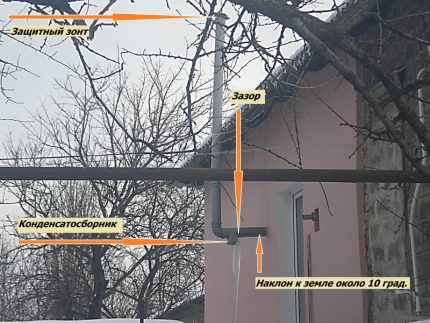

Even with the correct installation of all elements of the ventilation system, condensate drainage is not always effective, since it may freeze and form an ice plug
The second most important indicator is vapor permeability. Many materials used for thermal insulation of ventilation have the ability to release moisture accumulated under them when the maximum voltage for them is exceeded.
By filling the pores of the material, moisture increases its thermal conductivity, thereby reducing the effectiveness of insulation. To prevent this from happening, a waterproofing coating is mounted on top of the heat insulator - a membrane capable of letting steam out, blocking its access to the inside.
Fire resistance determines how fireproof the thermal insulation will be. There are 6 fire resistance classes in total.
For air ducts, a zero-grade insulation is required, that is, having the highest fire resistance, and therefore the most fireproof.With multilayer thermal insulation and the fulfillment of a number of additional conditions, the use of materials of the first class of fire resistance is allowed
The air flow passing through the air ducts creates noise. In forced ventilation systems, a running fan also makes noise and vibrates. To prevent noise and vibration from being transmitted through rigid structures and not spreading through living quarters, damping devices and gaskets are used.
But most heat-insulating materials also have sound-insulating properties and, in addition to their main function, help to protect the house from unpleasant acoustic effects.
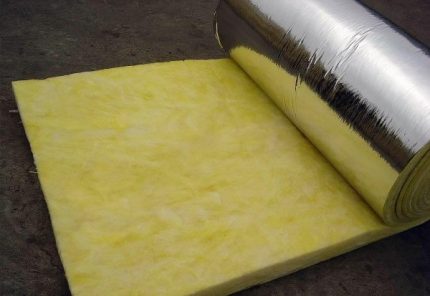

Mineral wool is one of the most popular thermal insulation materials in low-rise construction and is also used for thermal insulation of air ducts.
The materials used should not be a favorable environment for the vital activity of insects, molds, rotting bacteria and other harmful microorganisms.
Penetrating through the air ducts into living quarters, they can cause disease, and also damage the material itself, which may require its premature replacement. There are microorganisms whose waste products are so aggressive that they can burn through steel sheets 1.5 mm thick.
The materials used in the arrangement of ventilation communications must comply with sanitary and hygienic standards. The insulation should not release substances that are dangerous to humans and the environment. Environmental friendliness means the absence of the threat of contamination of the natural environment during disposal.
Allowable thermal insulation options
The above requirements are met by many mineral fiber materials, hydrocarbon polymers, foam elastomers, including:
- mineral wool;
- polyvinyl chloride;
- expanded polystyrene;
- polyurethane.
Foam elastomers are produced by extrusion and vulcanization. They have a porous structure, and the pores are bubbly, that is, closed, which reduces moisture absorption and makes them vapor-impermeable. Insulation materials such as polyurethane and polyvinyl chloride are obtained by polymerization of hydrocarbons.
Heat insulators are supplied on sale in the form of rolls, sheets (mats), hollow cylinders (shells). Roll materials and shells are suitable for thermal insulation of pipes and round ducts. Rectangular air ducts can be insulated with sheet material.
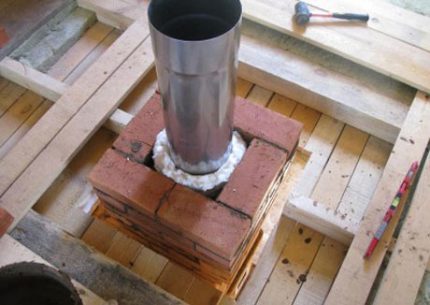

The air duct is insulated in all areas located in unheated rooms and ventilation ducts passing through walls, ceilings and roofs require special attention
Sheets and rolls of insulation are highly flexible, easy to shape, one side of them can be smooth. Due to the combination of these properties, the installation of thermal insulation is greatly facilitated. Many materials are not only fire-resistant, but also self-extinguishing, which increases fire safety.
Insulation is chosen taking into account the conditions of the environment in which it will be used, including the operating temperature. For central Russia, materials that can withstand ambient temperatures in the range from -30 ° C to 60 ° C are suitable for thermal insulation of ventilation systems.
A polyethylene (PE) film and a polyvinyl chloride (PVC) membrane are used as waterproofing protection. The insulated ventilation ducts are closed from external damage with boxes sheathed with a board, plywood or aluminum sheets.
Expert advice
Based on the above information, you can give some practical advice to help avoid condensation in the ventilation system.
- Carry out thermal insulation measures along the entire length of the air ducts that pass through unheated rooms and the street. It is imperative to insulate all additional devices present in the system.
- If the outlet pipe of the ventilation passes through a large section on the street, then a tee with a condensate drain must be installed on it. But keep in mind that at low temperatures, condensation can freeze inside the device.
- Mandatory installation on the upper end of the ventilation pipe of the visor or deflector.
- Install a flow hood in the kitchen with an outlet to the street or a fan in the window. This is the room with the highest humidity when food is being prepared.
Features of the insulation of the duct from the inside
It is necessary to insulate all air ducts outside the heated premises, including areas in the walls. Insulation of both external and internal surfaces of air ducts is possible.
If the insulation is carried out from the inside, already at the design stage, an increase in the duct cross-section is provided in accordance with the thickness of the heat-insulating layer. Otherwise, its bandwidth will decrease.
Mineral wool fibers are strengthened with adhesives. This is to prevent the fibers from peeling off by the air blast. The glue used for this purpose should not affect the level of fire resistance of the insulation and its environmental friendliness.


In order not to decrease the aeration properties of the ventilation duct, it is better to carry out insulation from the inside according to the "pipe-in-pipe" scheme. This is how a chimney sandwich is constructed. If there is no time and desire to do them yourself, you can buy ready-made
The thermal insulation laid on the inside should not increase aerodynamic resistance, slowing down the movement of air masses. That is, it is necessary to make its surface smooth.
Due to additional requirements for internal thermal insulation, its use is often impractical. Including if you have to insulate an already built ventilation system with a given cross-section of air ducts. In such cases, the air ducts are insulated from the outside.
Disposal of condensation on pipes
Condensation control must be rational
If it was not possible to completely get rid of moisture droplets or prevent their appearance in any of the ways, you need to pay attention to other reasons:
- Weather conditions - humid climate and frequent prolonged rains, prolonged severe frosts or heavy snowfalls increase the humidity level in the room, and as a result, condensation appears.
- The location of the house near natural water bodies, the close occurrence of groundwater affect the level of humidity in the house.
- Disadvantages of construction - no foundation waterproofing layer is laid, no ventilation, cold floor or damp basement located under the house.
- Frequent failures of the water supply system, the presence of several sources of evaporation (drying clothes, cooking) are also causes of condensation.
Most often, to solve this problem, it is required to completely change the internal microclimate of the house, and this requires complex complex measures, up to major repairs. Each of the situations where condensation occurs requires a study of the causes and an individual choice of a method and method of elimination.
Sometimes activities can be simple and cost effective.
- If there is excessive moisture, eliminate the source. Use only well-ventilated areas to dry laundry.
- Equip the exhaust ventilation so that it works in several modes, including forced.
- Additionally insulate the walls and floor.
- Install an air conditioner with moisture dehumidification function. If this is not possible, then make a moisture absorber yourself.
Condensation can almost always be observed on cold water pipes. This phenomenon not only spoils the appearance of the bathroom to some extent, but can cause serious problems. Constantly wet tubing has a limited life.
Therefore, such a problem should be solved very quickly. In this case, questions arise, what to do if water drops are found on the pipeline and how to remove condensate from cold water pipes. First, you don't need to over-dramatize the situation. Secondly, you need to familiarize yourself with all methods of eliminating this problem. Thirdly, choose the most optimal option and apply it in practice.
The procedure for installing thermal insulation outside
The most economical thermal insulation material for a private house is the time-tested mineral wool. It comes in rolls of various widths and can have one or two outer foil layers.
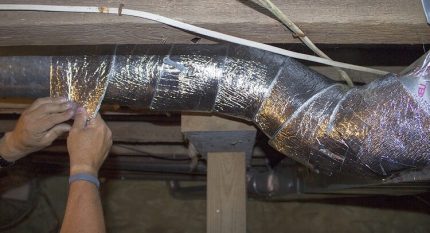

The thermal insulation material is installed overlapped on the ventilation pipe so that there are no unprotected areas, the joints are glued on top with adhesive tape
When determining the thickness of the heat-insulating layer, they are guided by SNiP 2.04.14–88. Heat engineers perform complex calculations taking into account the diameters of the pipes, the coefficient of thermal conductivity of the used heat-insulating material.
They take into account the average annual air temperature and even possible heat loss through joints and fasteners, as well as other parameters, most of which can be found in reference books and the above SNiP.
Speaking specifically about mineral wool, then when insulating ventilation systems in private houses located in central Russia, roll material with a thickness of 100 mm is usually used. You can buy 50 mm mineral wool and wrap the pipe twice.
To determine the required width of the insulation, measure the diameter of the pipe, add the thickness of the mineral wool multiplied by two to the obtained value. Multiply the resulting amount by 3.14 (pi).
Getting started, prepare in advance a rubber spatula, a construction knife, a stapler, aluminum tape 7-8 cm wide, a marker and measuring tools - a square, a ruler and a tape measure (preferably metal). Be sure to wear protective clothing.
A day without precipitation is chosen for work in the open air. Otherwise, the mineral wool may get wet. The roll is unrolled, marked and cut to obtain the desired size cut. Separate the foil along the edge so that the pipe can be wrapped with an overlap of mineral wool and cover the connecting seam with a foil layer.


In hard-to-reach places, a modern type of heat insulator is used - the so-called shell, which must be selected taking into account the outer diameter of the pipe
Then the connecting seam with a step of 10 cm is fixed with a stapler and glued with tape along the entire length. To fix the insulation to the pipe, both special fasteners and ordinary wire are used.
To protect the joints of the air ducts, the insulation is cut into fragments of the appropriate shape and size. Do not forget to clean the pipe from dirt before insulation.
Insulation can also be performed using segmented heaters. The monolithic casing is in the form of a pipe and is threaded onto the duct. It is mainly used during the installation of a ventilation system "from scratch".
Having measured the geometric parameters of the duct, a casing is selected that is suitable in size and stretched along the entire length of the pipe. Foil is wound over and fixed with stainless steel or copper clamps.
The collapsible shell consists of two semi-cylinders, which are applied to the pipe from both sides and fixed. On the sections passing through the wall, it is difficult to wrap the pipe in a roll of insulation, and it is much easier to put on the shell. The collapsible shell can be put on an existing air duct.
We fix the flaws of the system
The easiest and fastest way to eliminate is to deal with defects in the ventilation system, to eliminate the reasons due to which condensation is ready to form.
- Fight moisture.Destroy all puddles, streams and rivers of moisture in the apartment immediately after a leak occurs - try to clean it up immediately. This method is not a way to deal directly with pipe defects, but an important preventive measure.
- Clearing the channel from all kinds of debris that has gotten inside over the years of operation. The kitchen is a particularly fertile ground for dust and soot that fills the canal walls. Sometimes a simpler solution is not cleaning, but removing a piece of pipe in which a "plug" has occurred, a new, clean one is installed in place of the cut part.
- Isolation of channels. In a private house, this work is easier to do than in a city apartment, since it is easier to get to the ventilation system. Mineral or other heaters are used as the material, they are wrapped around the pipe and fixed with special glue or tape. Insulation of a wet pipe will be a mistake - it should first be thoroughly dried, and pipes with impaired tightness of the joints. The job will go to waste if the insulation is wet. An alternative method of thermal insulation is the use of a cable heater.
- Blurring the temperature difference. Another way to combat condensation is to bring the temperature difference between the air duct and the supply flow to a relative equality. For this, heaters are used - heaters.
- Removing the pipe. It is not always possible to get to the pipe and there is nothing to do here - all that remains is to bring the pipe to its colleague leading out into the street. This method is applicable in a cottage and in an apartment building.
- Creation of new ventilation. What if the pipe cannot be repaired at all, and condensate is still forming and forming? The old, unjustified system is drowned out, and instead of it, another ventilation is carried out in the room, a new one. Let's say by installing a suction fan and supplying valves. This method is very expensive - the devices themselves are relatively cheap, but the construction work will require a lot of capital investment. However, sometimes there is no other way out. It is better to entrust the execution of calculations and the work itself to a company that specializes in such matters.
Dampness and dirty air are the elements that destroy human life, make it uncomfortable and unsafe.
Ventilation is linked to the supply of air and, moreover, it is linked to other systems in the home. The problems with her must be resolved and as soon as possible before a major disaster strikes.
Condensation control by example
Let's consider a specific situation. The one-story private house has a ventilation system that provides air exchange in the bathroom and kitchen. Metal ventilation pipes are connected to these rooms.
They are laid in the attic with a subsequent exit to the roof. With daily temperature fluctuations, condensation forms in the pipes. But especially its large amount is observed in winter, when water drips from the hood, collecting in a puddle.
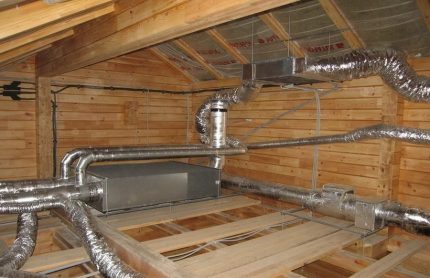

Attics are usually not heated, so ventilation pipes laid in this room need to be insulated along their entire length.
The problem is solved comprehensively. Insulation of the exhaust and supply pipes is in progress. The pipes are insulated from the entrance to the ceiling to the exit to the outside. In areas passing through an unheated attic space, pipes are insulated with rolled mineral wool 70-100 mm thick.
In the places of passage through the ceiling and overlap, shells are used. At the lowest point, a tee with a condenser collector is installed.
If the ventilation ducts do not pass through the roof, but through the wall, a section in the wall is insulated with the help of a shell. Outside the house, a 90-degree tee is installed on the ventilation pipe, a condensate trap and an umbrella (deflector) are mounted.
Causes of condensation in ventilation
Moisture inside ventilation pipes can form due to:
- lack of thermal insulation of air ducts;
- use of low-quality materials for carrying out insulation measures;
- violations of the tightness of ventilation ducts;
- improper assembly of the ventilation system;
- too high level of humidity in the room;
- clogged ventilation pipes;
- defects and damage to the main building structures (flooding of the foundation, dampness in the basement, insufficient insulation of the floor and walls, etc.)


The reasons for the appearance of condensation can also be a faulty water supply in a private house, the presence of constant sources of evaporation and the peculiarities of the climate in the region of residence. In any case, if water is dripping from the hood, then it's time to take urgent action.
Construction of a new ventilation system
Due to errors in design and installation, when using low-quality pipes, all measures to combat condensate may be in vain.
In this case, it is economically expedient to drown out the old and equip a new ventilation system that would cope with its functions of removing contaminated air and supplying fresh air masses.
Design is carried out only after analyzing air exchange processes and calculations in accordance with the standards specified in SNiP, based on the characteristics of the ventilated premises and the number of residents. It may be necessary to abandon natural ventilation in favor of forced ventilation with a change in the configuration of ventilation ducts and the installation of equipment for heating the supply air.
